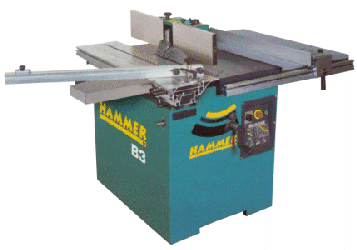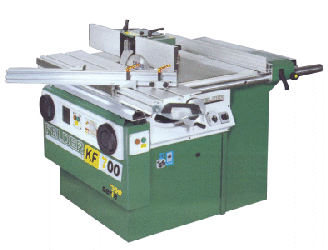| The question "what are the differences between Hammer and
Felder machines" has been asked more than once on the FOG forum and I have been asked
a few times myself via email. This being the case I thought I would go ahead and throw up
a web page just to answer this question. The items mentioned on this page are primarily
regarding the saw and shaper functions since that is what I am familiar with, there may be
a few more noteworthy items on jointer / planers that I may have missed. Differences:
- The cost of a similar
Felder machine is several thousand dollars more than a Hammer. (the exact amount depends
on options and what ever sales might be in effect at the time of purchase).
- Although they look
similar, the Felder uses a different mechanism for the sliding table. The parts that
make up the sliding table are measurably larger which should impart more strength
resulting in less flex when extended. The Felder uses roller bearings instead of the
more common ball bearing design. This allows more contact area in the sliding parts.
There is probably little difference in measurable accuracy between these two
designs but when extended the Felder should have less droop. Also, because it is
beefier the Felder is able to handle cantilevered loads (accessories) much more so than
the Hammer.
- The operator controls on a
Felder are different. Dedicated crank wheels with folding handles are used in place of a
single crank handle and each function has it's own electrical switchgear.
- The Felder is heavier by
200 - 400 pounds, this weight indicates heavier components or structures in some areas.
The cabinet or chassis is made of heavier gauge metal (the Hammer is a heavy gauge
too though) and the trunions and fence systems are beefier.
- The components and
accessories used on the Felder are more numerous, a little better, and more robust in
general; a good example of this is the simple crosscut fence stop on the Hammer compared
to the stop used on the Felder which has a retractable stop with a magnified cursor for
positioning accuracy. Another example is in the size of the crosscut fence itself,
while the Hammer is certainly adequate, the Felder is super heavy duty by comparison.
- The Felder shaper spindle
is a "quick change" type, it takes much longer to change out the spindle on a
Hammer since it is not designed for this.
- The Felder shaper fence
can be removed and replaced without loosing its (coarse) reference. This is true as
long as you aren't looking for repeatability more than a few thousandths of an inch.
- The Felder shaper fence is
larger and more robust in general. This makes the fence controls a little more
ergonomic in operation but the increase in size also means that it is heavier and thus
more effort is required to install and remove from the machine.
- The Felder incorporates
"below the table" collection for the shaper in addition to the connection via
the shaper fence. This should translate into a cleaner cabinet especially when the
shaper is operated with the spindle tilted.
- The Felder has a reversing
shaper spindle, the Hammer is not.
- The Felder rip fence is
useable whereas the Hammer rip fence (B3L) is inferior to even a $500 contractor saw.
The Hammer triangle fence is downright unsafe (in my opinion). The Felder rip
fence is still not quite as good as what is commonly found on cabinet saws but it is at
least good enough to use.
- I haven't heard of the
same types of jointer table alignment problems with the Hammer that have been reported on
the Felder. That doesn't mean they don't have problems but they don't appear on the FOG
forum.
- Both lines use European
motors built for 50Hz operation. The Felders are imported to the US with pulleys
sized so that the tool shaft speeds are compensated to run at some reasonable speed.
Hammers are imported with the same size pulleys as on European models, consequently
their tool shaft speeds are higher than typical. For example, the Hammer saw blade
spins at 5760rpm (which is too fast and will cause problems with 12" blades) versus
4800rpm on a Felder. I believe the blade speeds are still a little high for best
performance.
- The Hammer eccentric clamp
will only work from the side of the workpiece that is not against the fence. The sliding
table has only one slot for the clamp (the Felder has two) and the clamp is not long
enough to reach over the fence from this slot so the clamp placement is more limited.
- The Felder has several
more options available for it than the Hammer. Some of these options are for higher
power motors and convenience features such as motorized controls to set planer thickness.
A variable speed option for all functions also exists. Only the lowest end
Felder machines are available with single phase motors.
Similarities:
- Same basic machine format and size.
- Same basic capabilities for rip, crosscut, shaper tilt, spindle
size and other core machine features like blade brake and soft start.
- Same dealer network (in the US).
- Same sorts of problems getting a machine delivered (meaning only
something that weighs over 1000lb isn't as easy to deliver as a typical 300lb stand-alone
machine).
- Same sorts of problems with the machines upon arrival (meaning it
appears from the entries on the FOG forum the Felder arrives with the same types of bad
parts and problems as a Hammer).
|

